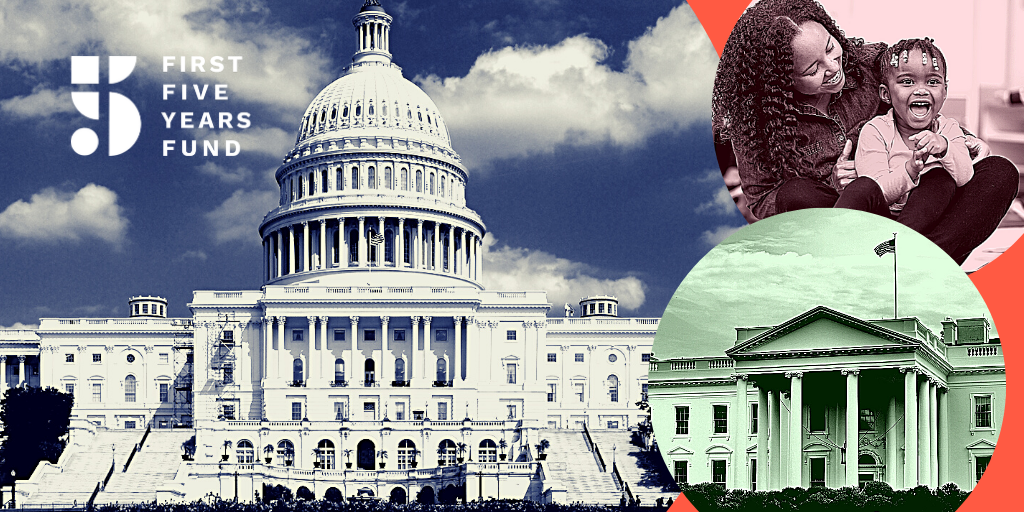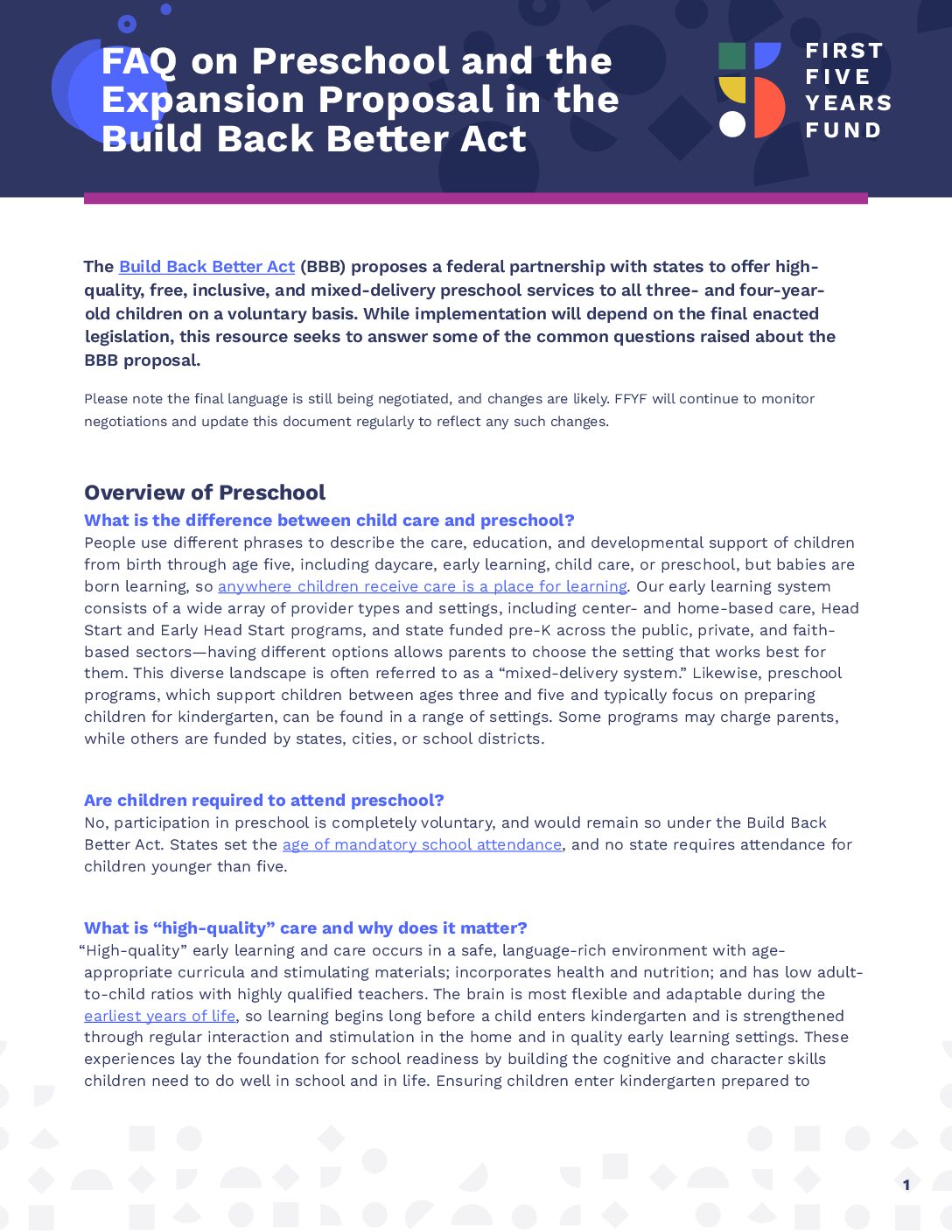FAQ on Preschool and the Expansion Proposal in the Build Back Better Act

The Build Back Better Act (BBB) proposes a federal partnership with states to offer high-quality, free, inclusive, and mixed-delivery preschool services to all three- and four-year old children on a voluntary basis. While implementation will depend on the final enacted legislation, this resource seeks to answer some of the common questions raised about the BBB proposal.
Please note the final language is still being negotiated, and changes are likely.
Overview Of Preschool
What is the difference between child care and preschool?
People use different phrases to describe the care, education, and developmental support of children from birth through age five, including daycare, early learning, child care, or preschool, but babies are born learning, so anywhere children receive care is a place for learning. Our early learning system consists of a wide array of provider types and settings, including center- and home-based care, Head Start and Early Head Start programs, and state funded pre-K across the public, private, and faith based sectors—having different options allows parents to choose the setting that works best for them. This diverse landscape is often referred to as a “mixed-delivery system.”
Likewise, preschool programs, which support children between ages three and five and typically focus on preparing children for kindergarten, can be found in a range of settings. Some programs may charge parents, while others are funded by states, cities, or school districts.
Are children required to attend preschool?
No, participation in preschool is completely voluntary, and would remain so under the Build Back Better Act. States set the age of mandatory school attendance, and no state requires attendance for children younger than five.
What is “high-quality” care and why does it matter?
“High-quality” early learning and care occurs in a safe, language-rich environment with age appropriate curricula and stimulating materials; incorporates health and nutrition; and has low adult to child ratios with highly qualified teachers. The brain is most flexible and adaptable during the earliest years of life, so learning begins long before a child enters kindergarten and is strengthened through regular interaction and stimulation in the home and in quality early learning settings. These experiences lay the foundation for school readiness by building the cognitive and character skills children need to do well in school and in life.
Ensuring children enter kindergarten prepared to learn and succeed helps avoid devastating achievement gaps that can be difficult and expensive to close as they transition to a K-12 setting. While high-quality pre-K has proven short- and long-term outcomes, it is most effective when paired with high-quality experiences for infants and toddlers and supports in the early grades that sustain and amplify early learning gains.
Why is federal investment needed?
Given the return on investment for preschool programs, both in terms of preparing children for kindergarten, as well as supporting parents’ ability to work or attend school, 44 states and the District of Columbia fund pre-k programs. These programs enrolled just 34% of 4-year-olds and 6% of 3-year-olds in the 2019-2020 school year, however. While some may attend other early learning and care programs, the majority of states (35) have an income requirement, making many children and families ineligible. Additionally, while recognizing their value, states have struggled to fund pre-k programs, particularly when faced with declining state revenue. The majority of states are prohibited from running a deficit, so such declines often lead to large spending cuts, putting discretionary programs, including pre-k, at particular risk.
States already rely on federal funding to serve preschool-aged children, particularly children from low-income families and children with disabilities or developmental delays. As with state programs, however, these programs reach a fraction of eligible children and families. Many more families making too much to qualify still struggle to find and afford high-quality early learning opportunities that are developmentally appropriate and inclusive for all students. To reach all three- and four-years olds will require a significant investment, one that state and local governments cannot shoulder on their own.
Why are education and wages for preschool educators so important?
Educators are vital to high-quality early learning and care, and education, training, and ongoing professional development are key to an educator’s success. As such they are increasingly required, but these requirements come with little financial incentive or support. Further, low adult to child ratios are important because, practically speaking, smaller groups are easier to manage, helping both children and adults feel safe and less overwhelmed. Low ratios also help ensure children receive positive, responsive caregiving, which is extremely important to their socio-emotional growth, physical well-being, and overall learning during a time of rapid brain development.
With many fixed costs and to avoid compromising quality by reducing staff, programs may reduce the cost they can control, compensation, to make tuition “affordable.” In 2020, the median salary was $25,460 per year or $12.24 per hour, and most child care workers lack benefits, including health care and paid sick or vacation time. To recruit and retain highly-skilled teachers, compensation must be sufficient to ensure a career in early childhood is sustainable and allows them to provide for their own families.
Preschool in the Build Back Better Act
Would the preschool system be school based?
No. States are required to support a mixed-delivery system and facilitate the participation of Head Start and other programs offered by eligible providers. “Eligible providers” include Head Start agencies; local school districts that are licensed by the state or meet comparable health and safety standards; licensed child care providers (including center-based providers, family child care providers, and community- or neighborhood-networks of family child care providers); or a consortia of such entities. States must certify that preschool seats will be distributed equitably among child care (including family child care), Head Start, and schools within the State. At the federal level, the program will be administered by the U.S. Department of Health and Human Services (HHS) in collaboration with the U.S. Department of Education (ED).
How would this impact existing programs?
Existing programs that meet the requirements outlined in the bill would be incorporated into a state’s universal pre-K (UPK) program. Preschool programs already take place in a variety of settings, including schools, places of worship, and child care centers. This mixed-delivery approach allows families to choose the program type that best meets the needs of both parents and children. Further, for providers, serving a mix of younger and older children helps to balance costs, which are driven by adult-to-child ratios; infant and toddler care tends to be more expensive because more adults are needed per child, but as children grow more independent fewer staff are required. Pooling these costs allows providers to offset the expense of infant and toddler care, so families don’t have to pay the true cost of caring for babies. Given the necessity of this balance, BBB requires states to ensure the preschool program does not disrupt the stability of infant and toddler care throughout the state.
Because of these benefits, some states have used the mixed-delivery model to expand pre-K opportunities, while also ensuring high-quality care remains available for all children from birth through age five. These examples provide a roadmap for states going forward, allowing them to scale up existing programs and avoid negative ripple effects to the rest of the early learning and care system. The work supported by the Preschool Development Grant Birth through Five program (PDG B-5) can also guide these efforts. Nearly all states and territories have received grants to conduct strategic planning and needs assessments, providing a blueprint for strengthening existing programs and expanding access to address gaps in state systems. Further, PDG B-5’s emphasis on parental choice, fostering partnerships among stakeholders and programs, and continuous improvement will be vital in building out a pre-
Are there new requirements for providers?
Yes. Within seven years of enactment, states must require educational qualifications for teachers including, at a minimum, requiring lead teachers to have a baccalaureate degree in early childhood education or a related field. The degree requirement would not apply to individuals employed by an eligible child care provider or early education program for three of the last five years with necessary content knowledge and teaching skills as determined by the state. States must also partner with at least one institution of higher education to facilitate degree attainment for staff of preschool programs. Sub-grants or contracts with providers will be for at least three years.
The proposal also includes new wage requirements for providers. States must ensure all preschool services provide salaries and salary schedules for preschool staff that are equivalent to salaries of elementary school staff with similar credentials and experience, and at a minimum, provide a living wage for all staff of such providers.
What else is required of UPK programs?
BBB requires states to prioritize establishing and expanding preschool in high-need communities and to support a mixed-delivery system. Within 18 months of receiving funds, states must have in place standards that, at a minimum, are as rigorous as the school readiness section of the Head Start Program Performance Standards (HSPPS), include standards for class sizes and ratios, and use Head Start duration standards (at least 1,020 annual hours). Programs must meet these requirements within 1 year of receiving funds. States must also have policies for expedited enrollment for certain populations and prioritize localities serving high-need communities.
How would universal pre-k (UPK) be funded?
The BBB appropriates $4 billion in FY2022, $6 billion in FY2023, $8 billion in FY2024, and “such sums as may be necessary” in FY2025-FY2027 to cover the federal share of the cost of UPK programs. To increase the quality and supply of services, no state match is required in the first three years (FY2022-FY2024). Starting in FY2025, however, states must contribute a 10% match, in cash or in kind. The required state match would increase incrementally, stopping at 40% in FY2027. Spending on “state activities” (administration, supporting continuous quality improvement, outreach and enrollment support, data systems building, supporting staff degree and credential attainment, ensuring access to children with disabilities, transportation, and updating needs assessment) must be matched at 50% in FY2025-FY2027. The maximum match for state activities would be capped at 5% of expendituresfor preschool services.
Federal funds must supplement, not supplant, other federal, state, and local funds for early childhood care and education programs. Thus a state must maintain its investment in any existing publicly-funded preschool programs or state-funded Head Start programs. If a state reduces per child spending, HHS (in collaboration with ED) may correspondingly reduce federal funds.
What will happen if a state “opts out” of this funding?
Generally, things will remain unchanged. In those states, the proposal includes $9.5 billion in FY2022 (available until September 30, 2027) for grants to localities to establish their own preschool programs in accordance with the law and an additional $9.5 billion in FY2022 (available until September 30, 2027) for grants to a Head Start agency to carry out the purposes of the Head Start Act. The Secretary may reallot funds from states without an approved application or with unobligated funds to an eligible locality or Head Start agency and may also recoup any unused localities grants funding for Head Start expansion grants in nonparticipating states.
Is Head Start included in the proposal?
Yes. In addition to being eligible providers, states must describe how they will partner with Head Start agencies to ensure the full utilization of Head Start programs. Further, from amounts appropriated for preschool, the proposal designates $2.5 billion annually for FY2022-2027 to improve compensation for Head Start staff, and Head Start agencies may apply for grants to localities in states that opt out of funding. The proposal doesn’t amend how Head Start operates or its existing funding
Subscribe to FFYF First Look
Every morning, FFYF reports on the latest child care & early learning news from across the country. Subscribe and take 5 minutes to know what's happening in early childhood education.




